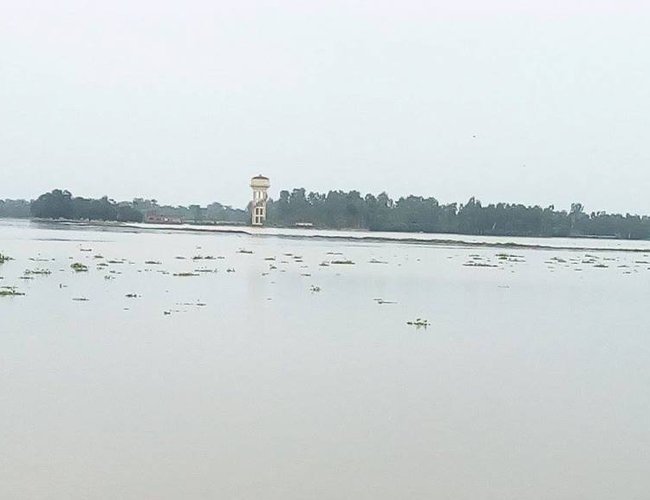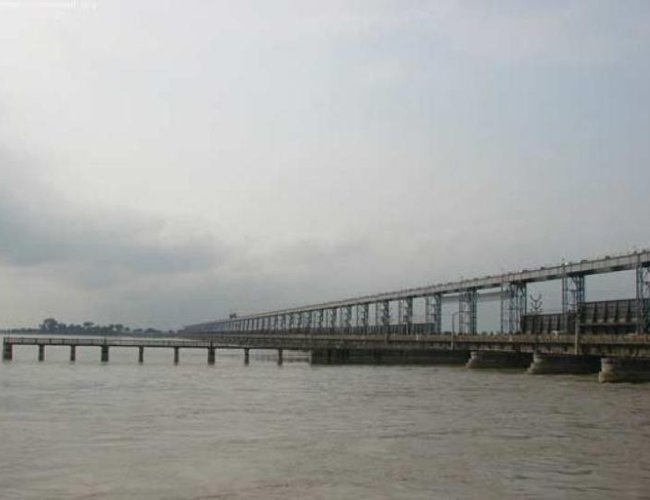
Without assessing the real damage the floods were causing, the government relied on its own resources for a week to carry out the rescue and relief operations under a one window system, preventing the international humanitarian agencies to get involved in saving human lives.
As the humanitarian crisis deepened in the flood-affected areas, while the government was finding it hard to provide relief and rehabilitation to tens of thousands of victims, it issued letter a letter on August 18, calling on all diplomatic missions to provide emergency relief assistance.
The delay of almost a week in issuing the statement cost Nepal dearly. Had Nepal issued the call a week ago, many more of Nepal’s flood victims would not have to suffer for weeks without relief materials and face the dire consequences they did. Although it was belated call, the international community and Nepal’s bilateral donors responded positively to support Nepal’s humanitarian crisis.
During floods, every minute counts. The earlier the relief and rescue missions reach the families, the more time there will be to relocate livestock and to ensure that everyone evacuates to reach higher ground.
Although China and India are two neighboring countries, which have offered the support of 1 million and 4 million dollars respectively, the Japanese Government was the first to announce an emergency assistance to Nepal in response to the damage caused by the heavy rainfall.
Upon the request of the Government of Nepal, the Government of Japan decided to provide emergency relief goods (blankets, plastic sheets etc.) through the Japan International Cooperation Agency (JICA) in response to the damage incurred by the floods caused by the heavy rainfall since August 11 in the southern area of the country on August 20.
According to a press release issued by the Embassy of Japan, upon the request of the Government of Nepal, and in light of the friendly relations between Japan and Nepal, Japan decided to provide the emergency assistance to Nepal to meet its humanitarian needs.
“Immediately after the arrival of the relief goods at Tribhuvan International Airport, the Embassy of Japan will hand them over to the Government of Nepal,” said press release.
In view of the high demand for relief, Nepal government's disaster relief budget is peanuts. Tens of thousands of people spent the whole week beneath the open sky without food and water.
According to the report, more than 6 million people are affected by floods and mudslides, more than a million people are displaced from their homes, 150 people have been reported dead or missing in Nepal and 2,881 homes have been partially or completely destroyed.
This disaster has also submerged crops in Nepal’s fertile southern rim, threatening to drive thousands of people into hunger.
Many western diplomats based in Kathmandu have expressed surprise over the government’s current reluctance to call for support. “It is good your leaders are visiting flood affected areas in southern plains where the next round of election is going to take place next month,” said a western diplomat asking not to be quoted.
“We have enough water storage and some money to purchase relief materials. However, we cannot provide your government the support without an international call from the United Nations Humanitarian Agencies.
As warned by medical practitioners, there are reports of diseases breaking out on many areas. Half a dozen children died of diarrhea and, even, snakebite.
In Siraha, one of the highly affected districts in terms of floods, the Chief of the District Public Health Office, Chuman Lal Das, said patients suffering from diarrhea and common cold, among other diseases, had increased in the flood-affected areas. Das said that 12 patients were admitted to the local primary health centre.
“As Nepal’s flood affected areas share borders with India, Nepal cannot go alone. We don’t have any option other than to watch a big humanitarian crisis helplessly,” said a Nepali government official.
“We don’t need any foreign support. We can handle the crisis on our own. If someone likes to support in the crisis, they must come through us,” said Home Minister Janardan Sharma Prabhakar, who was watching such a big humanitarian crisis helplessly last week.
Nepal Army In Rescue
Whatever the kinds disasters, whether big or small, occur, Nepal Army is always first to reach for rescue and relief. As a frontline agency for rescue and relief, Nepal Army remains alert to carry out the work. This time is not exceptional. As soon as the government called the meeting, Nepal Army’s mission is first to reach in the various sites supporting community to rescue the people.
Although Nepal army has a very limited equipments for rescue, Nepal Army personal saved the life of dozens of people trapped in the flooded areas of Saptari, Sarlahi, Jhapa and Sunsari.
Along with rescue mission, Nepal Army has also involved in the distribution of relief materials.
“Nepal Army has mobilized all its units all over the country. We used our helicopters to carry out rescue and relief mission,” said,Brigadier General Jhankar Bahadur Kadayat, Nepal Army spokesperson and the Chief of NA Directorate of Public Relations
The Ministry of Home Affairs has asked all organizations and individuals willing to support flood and landslide victims to contact and coordinate with the concerned local level, District Natural Disaster Relief Committee, Central Natural Disaster Relief Committee and Prime Minister’s Disaster Relief Fund.
"This is fast becoming one of the most serious humanitarian crises this region has seen in many years and urgent action is needed to meet the growing needs of millions of people affected by these devastating floods," said Martin Faller, Deputy Regional Director for Asia Pacific, International Federation of Red Cross and Red Crescent Societies (IFRC).
“Millions of people across Nepal, Bangladesh and India face severe food shortages and diseases caused by polluted flood waters,” said Faller.
Flood levels reached record highs in Nepal’s rivers, according to local authorities. Flooding of major rivers such as Babai, Kamala, Kosi, Kankai, Rapti, Jamuna surpassed levels. This is the deadliest floods the country has ever faced.
Experts say more than one thirds of Nepal has been flooded and fear the humanitarian crisis will get worse in the days and weeks ahead.
Many areas remained cut off from the destructive floods and landslides, of 11 and 12 August. Villages and communities were stranded without food, water and electricity. "This tragic flooding in Nepal has claimed at least 128 lives and 33 people are still missing," said Dev Ratna Dhakhwa, Secretary General, Nepal Red Cross Society.
Food crops have been wiped out by the floods in Nepal’s major farming and agricultural lands in the south of the country. “We fear that this destruction will lead to severe food shortages," Dhakhwa added.
IFRC has released 500,000 Swiss francs from its Disaster Relief Emergency Fund (DREF) to support the response efforts of the Nepal Red Cross. With the full picture of needs still emerging, this support may increase in the coming days.
“The more we studied the pace and path of the floods during the monsoon season, the more convinced we became that existing notification plans and structures between the national governments of Nepal and India were not as effective as they could be, and in fact, oftentimes lagged behind the rushing waters of the floods,” said an expert.
Cross Border Collaboration
Floods cannot be handled by one nation alone. There is the need of collaboration among the communities and countries. Some INGOs and NGOs are working to bring the communities together to understand the issue.
In the ensuing year, we sought to better tackle those additional pieces, looking at household savings for emergencies, adaptations necessary to sustain livelihoods and insurance programs to prepare for the worst.
Although floods wreaked havoc in Terai on 12 August, life is yet to come to normal. In lack of proper shelter and enough food to eat, the flood victims are struggling to keep pace with life.
Lust For Embankment
Although inappropriately built embankments have created problems, people see embankments may save them from another flood while building a house, they say, cannot prevent floods.
In Saptari, local people are reportedly working to build a strong embankment along the banks of Khado River amid hunger and all the inconvenience.
“Monsoon is going to be here for some time. So we are extremely worried that it might once again flood our settlements,” said Ramesh Mukhiya, a local of Sakarapura. “We need to build an embankment along the banks of the Khado River before building our house.”
The flood has fully damaged around 200 houses in Sakarapura. Over 1000 houses were inundated by the floods. Khado River is around 200 meters away from the settlement and the embankment has been almost destroyed.
“Building the embankment is more important than slamming the government and indulging in politics,” said Radhadevi Khanga, a flood victim. “As soon as the rain stopped we got to work without wasting time. We all got together and decided to build the embankment because it’s very important,” she added.
Scores of flood victims in Saptari, Siraha, Dhanuha and Rautahat districts have been deprived of relief packages after the concerned authorities turned their backs to address their plight.
Monsoon rains and floods cannot be prevented but destruction and devastation of human lives can be minimized. For this, there is the need to forge collaboration and coordination between Nepal and India. Rains and floods have been there, they are happening now and they will be there in the future, what is required is to stop inappropriate construction of embankments.



Keshab Poudel
Poudel is the editor of New Spotlight Magazine.
- IWMI: SoLAR Global Science-Policy Forum Conference
- Apr 25, 2024
- CLA: Samriddhi For Skill Development
- Apr 23, 2024
- ECONOMY: Growth At 3.3
- Apr 16, 2024
- DPM’s SHRESTHA’S CHINA VISIT High Profile, Low Key
- Apr 14, 2024
- Maha Kumbha In Barahkshetra: A Sacred Festival In Sacred Koshi (Kaushiki) River
- Apr 09, 2024
















